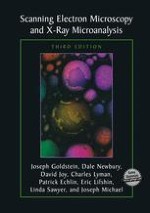2003 | OriginalPaper | Chapter
Image Formation and Interpretation
Authors : Joseph I. Goldstein, Dale E. Newbury, Patrick Echlin, David C. Joy, Charles E. Lyman, Eric Lifshin, Linda Sawyer, Joseph R. Michael
Published in: Scanning Electron Microscopy and X-ray Microanalysis
Publisher: Springer US
Included in: Professional Book Archive
Activate our intelligent search to find suitable subject content or patents.
Select sections of text to find matching patents with Artificial Intelligence. powered by
Select sections of text to find additional relevant content using AI-assisted search. powered by
Scanning electron microscopy is a technique in which images form the major avenue of information to the user. A great measure of the enormous popularity of the SEM arises from the ease with which useful images can be obtained. Modern instruments incorporate many computer-controlled, automatic features that permit even a new user to rapidly obtain images that contain fine detail and features that are readily visible, even at scanning rates up to that of television (TV) display. Although such automatic “computer-aided” microscopy provides a powerful tool capable of solving many problems, there will always remain a class of problems for which the general optimized solution may not be sufficient. For these problems, the careful microscopist must be aware of the consequences of the choices for the beam parameters (Chapter 2), the range of electron–specimen interactions that sample the specimen properties (Chapter 3), and finally, the measurement of those electron signals with appropriate detectors, to be discussed in this chapter. With such a systematic approach, an advanced practice of SEM can be achieved that will significantly expand the range of application to include many difficult imaging problems.
